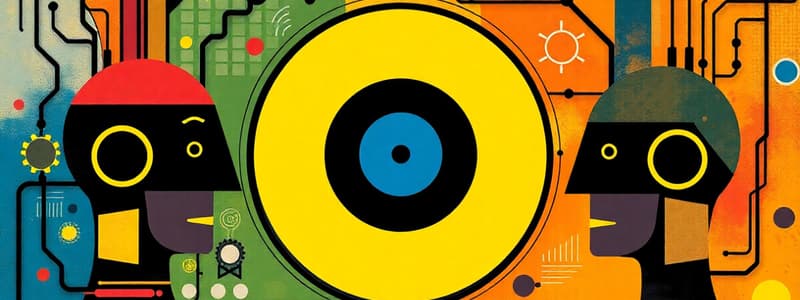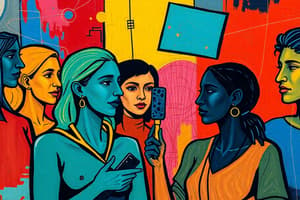Podcast
Questions and Answers
Is technology nowadays a necessity or a want?
Is technology nowadays a necessity or a want?
Technology can be viewed as both. For many aspects of modern life, such as communication, healthcare, and employment, certain technologies are necessities. However, many specific gadgets or upgrades might be considered wants, driven by convenience or desire rather than fundamental need.
When and where was the Universal Declaration of Human Rights (UDHR) proclaimed?
When and where was the Universal Declaration of Human Rights (UDHR) proclaimed?
The UDHR was proclaimed by the United Nations General Assembly in Paris on 10 December 1948.
The Universal Declaration of Human Rights (UDHR) has been translated into fewer than 100 languages.
The Universal Declaration of Human Rights (UDHR) has been translated into fewer than 100 languages.
False (B)
What potential societal issue arises from machines and sophisticated computers replacing manual labor?
What potential societal issue arises from machines and sophisticated computers replacing manual labor?
According to the presentation, what development might lead robots to eventually act and decide like humans?
According to the presentation, what development might lead robots to eventually act and decide like humans?
What industry's growth was enabled by technology, but might also be threatened by further technological advancements like AI?
What industry's growth was enabled by technology, but might also be threatened by further technological advancements like AI?
Besides unemployment, what other considerations arise from the widespread use of AI?
Besides unemployment, what other considerations arise from the widespread use of AI?
According to Nicholas Carr (2008), what happens to human intelligence as we increasingly rely on computers to mediate our understanding of the world?
According to Nicholas Carr (2008), what happens to human intelligence as we increasingly rely on computers to mediate our understanding of the world?
What outcome is predicted if robots replace humans in the workforce on a massive scale?
What outcome is predicted if robots replace humans in the workforce on a massive scale?
What organization proposed a technology-based ethical framework for robotics?
What organization proposed a technology-based ethical framework for robotics?
Which of the following is NOT listed as one of the ethical values and principles identified by COMEST for robotics?
Which of the following is NOT listed as one of the ethical values and principles identified by COMEST for robotics?
According to Asimov's First Law of Robotics, a robot must always obey orders from human beings.
According to Asimov's First Law of Robotics, a robot must always obey orders from human beings.
State the Second Law of Robotics as devised by Isaac Asimov.
State the Second Law of Robotics as devised by Isaac Asimov.
Under what condition must a robot protect its own existence, according to the Third Law of Robotics?
Under what condition must a robot protect its own existence, according to the Third Law of Robotics?
Match the Philippine Republic Act with its common name or purpose:
Match the Philippine Republic Act with its common name or purpose:
Should society be worried about robots replacing workers? Support your answer.
Should society be worried about robots replacing workers? Support your answer.
What are some examples of process-driven jobs that are under serious threat from robots and AI?
What are some examples of process-driven jobs that are under serious threat from robots and AI?
Flashcards
Universal Declaration of Human Rights
Universal Declaration of Human Rights
A document proclaimed by the United Nations General Assembly in 1948 to protect human rights.
Robots
Robots
Machines designed to perform complex, repetitive, or dangerous tasks, often resembling human beings.
Artificial Intelligence (AI)
Artificial Intelligence (AI)
The field of computer science focused on creating machines that can perform tasks that typically require human intelligence.
Technological Unemployment
Technological Unemployment
Signup and view all the flashcards
Three Laws of Robotics
Three Laws of Robotics
Signup and view all the flashcards
First Law of Robotics
First Law of Robotics
Signup and view all the flashcards
Second Law of Robotics
Second Law of Robotics
Signup and view all the flashcards
Third Law of Robotics
Third Law of Robotics
Signup and view all the flashcards
Data Privacy Act of 2012
Data Privacy Act of 2012
Signup and view all the flashcards
Study Notes
Learning Competencies
- Contemporary human experience needs evaluation, in order to strengthen the human person functioning in society.
- Important to discuss human rights in the face of changing social conditions and technological development
- Laws and policies should be identified to protect people's well-being amidst technological advancement and ethical concerns
Introduction
- Technology affects everyone in society, some way or another, whether they like it or not
- People heavily rely on various readily available technological advancements on a daily basis
- Technology is already an inevitable part of society
Question
- Is technology nowadays a necessity or a want?
Universal Declaration of Human Rights
- It is a milestone document in the history of human rights
- Drafted by representatives with different legal and cultural backgrounds from all regions
- The United Nations General Assembly proclaimed the Declaration in Paris on 10 December 1948 (General Assembly resolution 217 A)
- Represents a common standard of achievement for all peoples and nations
- It sets out fundamental human rights to be universally protected and translated into over 500 languages
- UDHR has inspired and paved the way for over seventy human rights treaties, which are applied today on a permanent basis at global and regional levels
Humans vs Robots
- Progress in science and technology accompanied by rise of machines may render humans useless
- Machinery is gradually replacing manual labor
- Computers are becoming more sophisticated
- Robots are usually designed like human beings
- Robots are created to perform complex, repetitive, or dangerous tasks
- With the development of artificial intelligence (AI), robots may also eventually act and decide like humans
- Important to reflect on ethical problems where machines adopt the nature of humans
Impact of Technology on the BPO Industry
- Technology empowers the growth of BPO industry, at the same time potentially eliminates it
- Investors and business people consider business analytics by artificial intelligence a good investment
- AI-driven decisions now arise from sophisticated statistical analyses made with massive data
- An estimated million Filipino BPO workers may be affected, losing their jobs due to artificial intelligence as of August 2017
- Unemployment is only one of the many ethical considerations in the widespread use of AI
- It raises questions about human value in relation to machines with AI and guarding against mistakes committed by machines with technology
- Technology may become a threat to human dignity and security
- People may also have to consider the ethical treatment for AI, machines/robots become more human-like
- As machines and robots approach having a human-like nature, humans may also have the tendency to become machine-like
Human Dependence on Technology
- Humans begin to function more like automatons with the swipe of the fingertips for things people need, conveniences to information
- The Internet has become an instant go-to tool for answers to questions
- People accept what the search engine, like Google, spews out in byte sizes and forget how to process, read, think further, or put things in context
- There is a danger of becoming less intelligent as the internet becomes more intelligent
- Relying on computers to mediate understanding of the world flattens own intelligence into artificial intelligence
- Society evolution along with science and technology gives rise to more and more complex issues
- Vital to protect and exercise human rights for everyone in the pursuit of a good life
- Important that amid these developments, humans become freer, more rational, and more loving in the practice of science and technology
Technology And Humanity Cross
- Building a just and progressive society entails the constant practice of the good with examining contemporary issues in science and technology information, genetically modified organisms, nanotechnology, and climate change
- It may be exhibited in exceptional scientific methodologies, personal virtue, social responsibility, and global concern
Future of Robots Replacing Humans
- Massive job losses could be a result if robots would replace humans
- Adapting ways to remunerate people would be necessary
- Basic decent salary for people who cannot find a job (older employees for example) should be guaranteed
World Commission on the Ethics of Scientific Knowledge and Technology of UNESCO (COMEST)
- Proposed a technology-based ethical framework on robotics ethics based on the distinction between deterministic and cognitive robots
- Identified ethical values and principles that set regulations at every level to Engineers, Scientists, etc
- Human dignity
- Value of autonomy
- Value of privacy
- “Do not harm" principle
- Principle of responsibility
- Value of beneficence
- Value of justice
Recommendations
- There is no way robots will replace Humans with these COMEST specific recommendations concerning the application of robotic technologies
- Teaching codes of ethics to roboticists need attention, retraining and retooling the work force, as well advising against developing and using autonomous weapons
- This ethical perspective justifies statement
Roles Played By Robotics
- Robots play different roles in the lives of the people and society as a whole
- They were invented to make life more efficient and less stressful
- Robots have a set of rules, characteristics define a good robot
Robotics Laws
- A robot may not injure a human being or, through inaction, allow a human being to come to harm
- A robot must obey the orders given it by human beings except where such orders would conflict with the First Law
- A robot must protect its own existence as long as such protection does not conflict with the First or Second Laws
- A robot may not injure humanity, or, by inaction, allow humanity to come to harm
Three Laws of Robotics
- Shortened to The Three Laws or known as Asimov's Laws
- A set of rules devised by science fiction author Isaac Asimov
- The rules were introduced in his 1942 short story "Runaround" (included in the 1950 collection I, Robot)
- Anticipated in some earlier stories
- The Three Laws, quoted from the "Handbook of Robotics, 56th Edition, 2058 A.D."
1st Law
- A robot may not injure a human being or, through inaction, allow a human being to come to harm
2nd Law
- A robot must obey the orders given it by human beings except where such orders would conflict with the First Law
3rd Law
- A robot must protect its own existence as long as such protection does not conflict with the First or Second Law
Local Government Policies
- Local government policies that protects the well-being of the person in face of new technologies
- Republic Act No. 10173 (Data Privacy Act of 2012
- 1987 Constitution
- Philippine Agenda 21
- Inter-Agency Committee on Climate Change
- Republic Act 8749 (Clean Air Act of 1999)
- Republic Act No. 8435 (Agriculture, Forestry Modernization Act of 1997)
- Republic Act No. 9003 (Solid Waste Management Act of 2000
- Republic Act No. 9275 (Philippine Clear Water Act of 2004)
- Administrative Order 171, 2007
- Republic Act No. 9729 (Climate Change Act of 2009)
- Philippine Climate Change Commission
- Natural Framework Strategy on Climate Change 2010-2022
Activity
- Should society be worried about robots replacing workers? Provide support for your answer
- What are the process-driven jobs that are in serious threats with robots and Al's? Provide comprehensive discussion
Studying That Suits You
Use AI to generate personalized quizzes and flashcards to suit your learning preferences.




